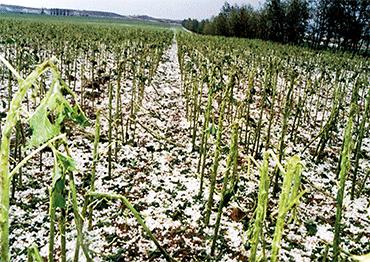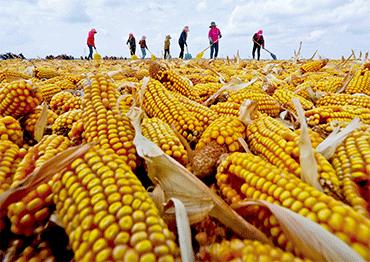On May 28, a severe hailstorm struck parts of Aksu including Shaya, Kuqa and Wushi counties, the golf ball-sized ice devastating over 6,667 hectares of cotton. “The hailstones crushed all the flowers and leaves, leaving nothing,” said Dai Lu, station master at Aksu agricultural technology center.
The hailstorm season in Northwest China has been getting longer. Luo Ji, deputy director of the Aksu regional meteorological bureau, said storms typically began in April to early May and lasted until late summer. But now, they start as early as March and continue into mid-October.
Experts say hotter and more humid weather is to blame. Luo Ji explained that increasing ground temperatures from solar radiation heat the atmosphere like “boiling water in a pot,” causing the intense updrafts that force raindrops into extremely cold areas of the atmosphere, where they freeze.
Luo Ji said the number and intensity of hailstorms in Aksu has increased in recent years, concentrating in the spring and autumn.
Between 2009 to 2020, there were up to 17.6 hailstorms annually. In 2019, hailstorm events reached historical highs for spring, summer and autumn. Seven occurred during autumn, a season that historically rarely saw hail.
The longer the hail period and the later the hail falls, the greater the impact on cotton production. In April, as cotton sprouts, damage caused by hailstorms can be mitigated with replanting. But if a hailstorm strikes in September when the cotton blooms, the destruction can be devastating.
Compared to concentrated hailstorms, the volatility and instability of temperature and precipitation can negatively affect agriculture over wider regions.
Many of the farmers NewsChina interviewed said that the number of extremely high and very low temperature days is increasing, while drought and flooding occur more frequently.
This year, Aksu experienced severe spring frost and extreme summer heat. Data from the local meteorological bureau showed cold snaps in mid-April and early May destroyed crops in most parts of Aksu. From May 6 to 7, Wushi, Baicheng and Kuqa counties saw their all-time latest recorded annual frost, forcing farmers in many areas to replant their cotton. “The spring frost this year was a very extreme phenomenon,” Ji said.
For cotton growth, according to Dai Lu, distribution of temperature during the growing period is more important. Over the last decade, extreme high temperature weather has become more frequent. Previously, the number of days above 35 C annually was generally no more than 10 days, but prior to August 2023, there had already been 20 days where temperatures reached over 35 C. “When the temperature gets very high, it adversely affects cotton pollination and makes the cotton flower buds fall off. For example, from mid-July to early August 2015, there were about 20 days of extreme high temperatures, which caused an average production loss of over 50 kilograms per mu,” Dai said.
Winter freezes also pose threats to agriculture in Xinjiang. Prolonged low temperatures can be fatal to orchards. Yang Junjie, senior engineer of Wensu County forestry technology promotion service center, told NewsChina that in December 2022, temperatures in Wensu County dropped to - 22 C for 25 consecutive days, freezing many trees to death and completely devastating walnut orchards. “It takes a long time for surviving trees to recover, and the negative effects will last for seven or eight years, resulting in declining production,” Yang added.

 Old Version
Old Version


